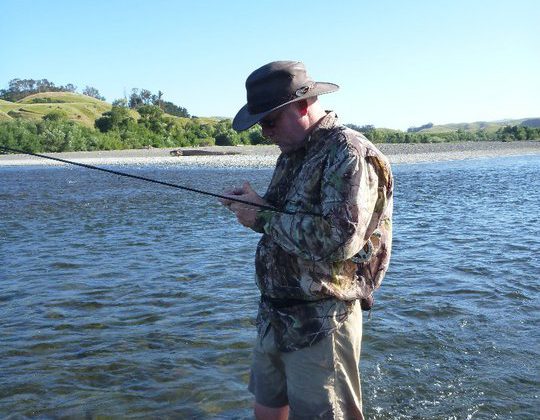Setting Up for a Cast I

My real passion in fly fishing is casting to fish so close I can see the fly. This really tests technique and casting ability. There is a lot that can go wrong when you fish in close, and over the years I have developed tackle and technique that gives me the best shot of landing these fish.
Often I will be fishing out of trees or from the wrong bank to cruising fish, rather than fishing the easy side of the river. This can make for some very interesting fishing, and always tests technique and tackle.
The great part about this very intense fishing is that the techniques and tackle used for this form of fishing improve all your other fishing.
Tackle is hugely important for this kind of fishing. I am torn between wanting one of two types of rods of quite different action. A very soft rod like my Scott G Series is ideal for making short accurate casts and can cast with a very small amount of fly line out. The other useful rod is a very fast one as while it doesn’t cast a short line well it casts very quickly with fewer false casts and can really muscle fish in.
I tend to take out my softer rod because it is more forgiving on the take and when fighting the fish. A soft rod acts as a big shock absorber which makes playing the fish a lot easier. It absorbs the surges better than a fast rod. On the other hand a fast rod really hammers the fish, which is why I am torn between the two completely different styles of fishing.
The principles of fishing close are equally applicable when fishing to fish further out. Set a solid casting platform. Strip line out when you have set the platform. Get all the line out you need to cast. Then make the cast. The video below shows me doing all these things to hook a rainbow first cast.
Get a Solid Casting Platform
This can not be emphasised enough. Make sure you have a stable base, whether you are standing, kneeling, lying or hanging out of a tree.
Even more importantly do not take your flies off the rod before you have a stable base. The only thing that can happen by taking your flies off too early is that you get a tangle as you move into position.
The Mike Kruse Crossover
Mike Kruse is a good mate and a good fisherman who has taught me a lot about fishing. The first time I fished with him he taught me how to set up my flies so I almost never get a tangle and always know where my flies are. This very mechanical repetition means that I can now remove my flies from my rod without looking, allowing me to watch a fish continuously rather than have to look down at my flies then look up and find the fish.
Take your bottom fly and hook it in the left hand side of your bottom guide. Then cross the leader over the handle of the rod, and past the right hand side of the reel. Wind the line tight. You may wish to reverse this if you are left handed.
Strip Out Line First
Keep your rod tip pointing down and take the flies off the top guide and around the butt of the rod. Your next move is crucial as if you get it wrong the fly line can fall back down into your rod and require frustrating remedial work. This is why I have a frayed braided loop on the end of my fly lines – it stops the line falling back down the guides.
Strip a good few feet of line off the reel and pull the flies to get that out the end of the rod tip. Repeat if you are casting a reasonable distance, holding the flies until you have enough line out to be able to make a cast.
Note if you set up your braided loop with a collar you will never have your fly line fall down the guides when removing the line from the rod.
This video shows a good casting set up to catch a fish first cast. It is using my Sage TCR with a long Airflo Polyleader.
